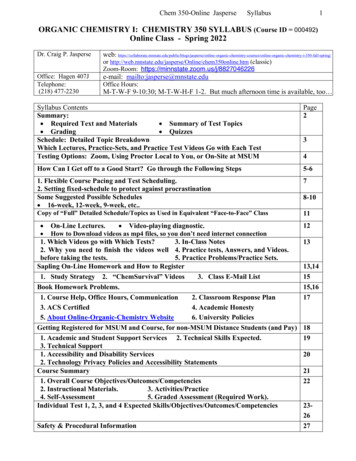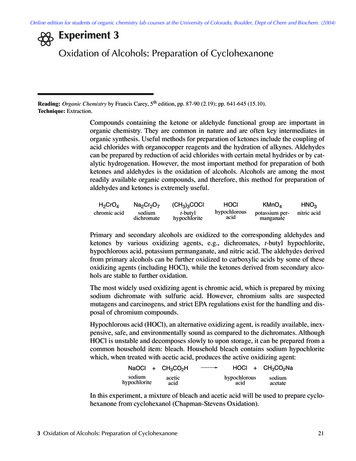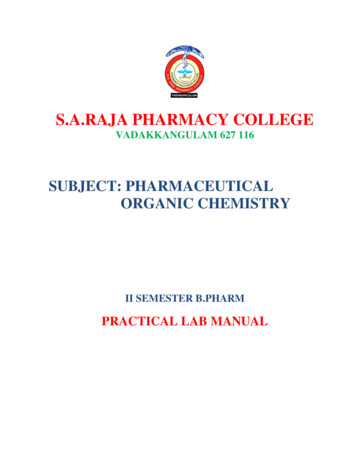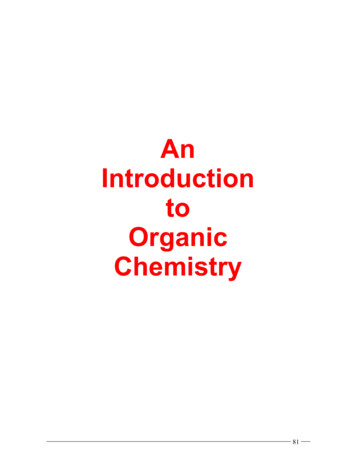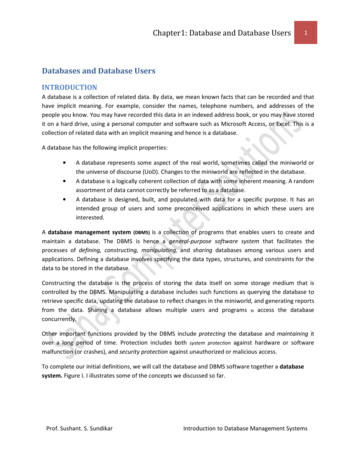
Transcription
C H A P T E R1The BasicsBONDING AND MOLECULAR STRUCTUREOrganic chemistry plays a role in all aspects of our lives, from the clothing we wear, to the pixels of our televisionand computer screens, to preservatives in food, to the inks that color the pages of this book. If you take the time to understand organic chemistry, to learn its overall logic, then you will truly have the power to change society. Indeed, organicchemistry provides the power to synthesize new drugs, to engineer molecules that can make computer processors runmore quickly, to understand why grilled meat can cause cancer and how its effects can be combated, and to design waysto knock the calories out of sugar while still making food taste deliciously sweet. It can explain biochemical processes likeaging, neural functioning, and cardiac arrest, and show how we can prolong and improve life. It can do almost anything.IN THIS CHAPTER WE WILL CONSIDER:t what kinds of atoms make up organic moleculest the principles that determine how the atoms in organic molecules are bound togethert how best to depict organic molecules[ WHY DO THESE TOPICS MATTER? ]At the end of the chapter, we will see how some of the unique organicstructures that nature has woven together possess amazing properties that we can harness to aid human health. Seefor additional examples, videos, and practice.photo credits: computer screen: Be Good/Shutterstock; capsules: Ajt/Shutterstock1
2CHAPTER 1THE BASICS: Bonding and Molecular StructureNASA/Photo Researchers, Inc.1.1 LIFE AND THE CHEMISTRY OF CARBONCOMPOUNDS—WE ARE STARDUSTSupernovae were the crucibles inwhich the heavy elements wereformed.Organic chemistry is the chemistry of compounds that contain the element carbon.If a compound does not contain the element carbon, it is said to be inorganic.Look for a moment at the periodic table inside the front cover of this book. More thana hundred elements are listed there. The question that comes to mind is this: why shouldan entire field of chemistry be based on the chemistry of compounds that contain thisone element, carbon? There are several reasons, the primary one being this: carbon compounds are central to the structure of living organisms and therefore to the existenceof life on Earth. We exist because of carbon compounds.What is it about carbon that makes it the element that nature has chosen for livingorganisms? There are two important reasons: carbon atoms can form strong bonds toother carbon atoms to form rings and chains of carbon atoms, and carbon atoms can alsoform strong bonds to elements such as hydrogen, nitrogen, oxygen, and sulfur. Becauseof these bond-forming properties, carbon can be the basis for the huge diversity of compounds necessary for the emergence of living organisms.From time to time, writers of science fiction have speculated about the possibility oflife on other planets being based on the compounds of another element—for example,silicon, the element most like carbon. However, the bonds that silicon atoms form to eachother are not nearly as strong as those formed by carbon, and therefore it is very unlikelythat silicon could be the basis for anything equivalent to life as we know it.1.1A What Is the Origin of the Element Carbon?Through the efforts of physicists and cosmologists, we now understand much of howthe elements came into being. The light elements hydrogen and helium were formed atthe beginning, in the Big Bang. Lithium, beryllium, and boron, the next three elements,were formed shortly thereafter when the universe had cooled somewhat. All of the heavierelements were formed millions of years later in the interiors of stars through reactions inwhich the nuclei of lighter elements fuse to form heavier elements.The energy of stars comes primarily from the fusion of hydrogen nuclei to producehelium nuclei. This nuclear reaction explains why stars shine. Eventually some stars beginto run out of hydrogen, collapse, and explode—they become supernovae. Supernovaeexplosions scatter heavy elements throughout space. Eventually, some of these heavy elements drawn by the force of gravity became part of the mass of planets like the Earth.1.1B How Did Living Organisms Arise?This question is one for which an adequate answer cannot be given now because thereare many things about the emergence of life that we do not understand. However, we doknow this. Organic compounds, some of considerable complexity, are detected in outerspace, and meteorites containing organic compounds have rained down on Earth since itwas formed. A meteorite that fell near Murchison, Victoria, Australia, in 1969 was foundto contain over 90 different amino acids, 19 of which are found in living organisms onEarth. While this does not mean that life arose in outer space, it does suggest that eventsin outer space may have contributed to the emergence of life on Earth.In 1924 Alexander Oparin, a biochemist at the Moscow State University, postulated thatlife on Earth may have developed through the gradual evolution of carbon-based moleculesin a “primordial soup” of the compounds that were thought to exist on a prebiotic Earth:methane, hydrogen, water, and ammonia. This idea was tested by experiments carried outat the University of Chicago in 1952 by Stanley Miller and Harold Urey. They showed thatamino acids and other complex organic compounds are synthesized when an electric spark(think of lightning) passes through a flask containing a mixture of these four compounds(think of the early atmosphere). Miller and Urey reported in their 1953 publication thatfive amino acids (essential constituents of proteins) were formed. In 2008, examinationof archived solutions from Miller and Urey’s original experiments revealed that 22 aminoacids, rather than the 5 amino acids originally reported, were actually formed.
31.2 ATOMIC STRUCTURESimilar experiments have shown that other precursors of biomolecules can also arisein this way—compounds such as ribose and adenine, two components of RNA. SomeRNA molecules can not only store genetic information as DNA does, they can also actas catalysts, as enzymes do.There is much to be discovered to explain exactly how the compounds in this soupbecame living organisms, but one thing seems certain. The carbon atoms that make upour bodies were formed in stars, so, in a sense, we are stardust.1.1C Development of the Science of Organic ChemistryThe science of organic chemistry began to flower with the demise of a nineteenth centurytheory called vitalism. According to vitalism, organic compounds were only those thatcame from living organisms, and only living things could synthesize organic compoundsthrough intervention of a vital force. Inorganic compounds were considered those compounds that came from nonliving sources. Friedrich Wöhler, however, discovered in1828 that an organic compound called urea (a constituent of urine) could be made byevaporating an aqueous solution of the inorganic compound ammonium cyanate. Withthis discovery, the synthesis of an organic compound, began the evolution of organicchemistry as a scientific discipline.An RNA moleculeONH4 NCO Ammonium cyanateheatH 2NCNH2UreaDespite the demise of vitalism in science, the word “organic” is still used today by somepeople to mean “coming from living organisms” as in the terms “organic vitamins” and“organic fertilizers.” The commonly used term “organic food” means that the food wasgrown without the use of synthetic fertilizers and pesticides. An “organic vitamin” meansto these people that the vitamin was isolated from a natural source and not synthesized bya chemist. While there are sound arguments to be made against using food contaminatedwith certain pesticides, while there may be environmental benefits to be obtained from organic farming, and while “natural” vitamins may contain beneficial substances not presentin synthetic vitamins, it is impossible to argue that pureOH“natural” vitamin C, for example, is healthier than pureOCH—CH2OH“synthetic” vitamin C, since the two substances are iden- OCCHtical in all respects. In science today, the study of compounds from living organisms is called natural productsC Cchemistry. In the closer to this chapter we will considerHOOHmore about why natural products chemistry is important.FOODCOLLECTION/Image SourceTHE CHEMISTRY OF. Natural ProductsVitamin C is found in variouscitrus fruits.Vitamin C1.2 ATOMIC STRUCTUREBefore we begin our study of the compounds of carbon we need to review some basic butfamiliar ideas about the chemical elements and their structure.t The compounds we encounter in chemistry are made up of elements combined indifferent proportions.t Elements are made up of atoms. An atom (Fig. 1.1) consists of a dense, positively charged nucleus containing protons and neutrons and a surrounding cloudof electrons.Each proton of the nucleus bears one positive charge; electrons bear one negativecharge. Neutrons are electrically neutral; they bear no charge. Protons and neutrons haveFIGURE 1.1 An atom is composed of a tiny nucleus containing protons andneutrons and a large surrounding volume containing electrons. The diameterof a typical atom is about 10,000 times the diameter of its nucleus.Electron cloudNucleus
4CHAPTER 1THE BASICS: Bonding and Molecular Structurenearly equal masses (approximately 1 atomic mass unit each) and are about 1800 times asheavy as electrons. Most of the mass of an atom, therefore, comes from the mass of thenucleus; the atomic mass contributed by the electrons is negligible. Most of the volumeof an atom, however, comes from the electrons; the volume of an atom occupied by theelectrons is about 10,000 times larger than that of the nucleus.The elements commonly found in organic molecules are carbon, hydrogen, nitrogen,oxygen, phosphorus, and sulfur, as well as the halogens (fluorine, chlorine, bromine, andiodine).Each element is distinguished by its atomic number (Z), a number equal to thenumber of protons in its nucleus. Because an atom is electrically neutral, the atomicnumber also equals the number of electrons surrounding the nucleus.1.2A IsotopesBefore we leave the subject of atomic structure and the periodic table, we need to examineone other observation: the existence of atoms of the same element that have differentmasses.For example, the element carbon has six protons in its nucleus giving it an atomicnumber of 6. Most carbon atoms also have six neutrons in their nuclei, and because eachproton and each neutron contributes one atomic mass unit (1 amu) to the mass of theatom, carbon atoms of this kind have a mass number of 12 and are written as 12C.t Although all the nuclei of all atoms of the same element will have the samenumber of protons, some atoms of the same element may have different massesbecause they have different numbers of neutrons. Such atoms are called isotopes.For example, about 1% of the atoms of elemental carbon have nuclei containing 7 neutrons, and thus have a mass number of 13. Such atoms are written 13C. A tiny fraction ofcarbon atoms have 8 neutrons in their nucleus and a mass number of 14. Unlike atoms ofcarbon-12 and carbon-13, atoms of carbon-14 are radioactive. The 14C isotope is used incarbon dating. The three forms of carbon, 12C, 13C, and 14C, are isotopes of one another.Most atoms of the element hydrogen have one proton in their nucleus and have noneutron. They have a mass number of 1 and are written 1H. A very small percentage(0.015%) of the hydrogen atoms that occur naturally, however, have one neutron in theirnucleus. These atoms, called deuterium atoms, have a mass number of 2 and are written2H. An unstable (and radioactive) isotope of hydrogen, called tritium (3H), has two neutrons in its nucleus.PRACTICE PROBLEM 1.1There are two stable isotopes of nitrogen, 14N and 15N. How many protons and neutronsdoes each isotope have?1.2B Valence ElectronsWe discuss the electron configurations of atoms in more detail in Section 1.10. For themoment we need only to point out that the electrons that surround the nucleus existin shells of increasing energy and at increasing distances from the nucleus. The mostimportant shell, called the valence shell, is the outermost shell because the electrons ofthis shell are the ones that an atom uses in making chemical bonds with other atoms toform compounds.t How do we know how many electrons an atom has in its valence shell? We look atthe periodic table. The number of electrons in the valence shell (called valence electrons) is equal to the group number of the atom. For example, carbon is in groupIVA and carbon has four valence electrons; oxygen is in group VIA and oxygen hassix valence electrons. The halogens of group VIIA all have seven electrons.PRACTICE PROBLEM 1.2How many valence electrons does each of the following atoms have?(a) Na(b) Cl(c) Si(d) B(e) Ne(f) N
1.3 CHEMICAL BONDS: THE OCTET RULE51.3 CHEMICAL BONDS: THE OCTET RULEThe first explanations of the nature of chemical bonds were advanced by G. N. Lewis (ofthe University of California, Berkeley) and W. Kössel (of the University of Munich) in1916. Two major types of chemical bonds were proposed:1. Ionic (or electrovalent) bonds are formed by the transfer of one or more electronsfrom one atom to another to create ions.2. Covalent bonds result when atoms share electrons.The central idea in their work on bonding is that atoms without the electronic configuration of a noble gas generally react to produce such a configuration because theseconfigurations are known to be highly stable. For all of the noble gases except helium, thismeans achieving an octet of electrons in the valence shell.t The valence shell is the outermost shell of electrons in an atom.t The tendency for an atom to achieve a configuration where its valence shell containseight electrons is called the octet rule.The concepts and explanations that arise from the original propositions of Lewis andKössel are satisfactory for explanations of many of the problems we deal with in organicchemistry today. For this reason we shall review these two types of bonds in more modernterms.[ HELPFUL HINT ]1.3A Ionic BondsAtoms may gain or lose electrons and form charged particles called ions.t An ionic bond is an attractive force between oppositely charged ions.One source of such ions is a reaction between atoms of widely differing electronegativities(Table 1.1).t Electronegativity is a measure of the ability of an atom to attract electrons.t Electronegativity increases as we go across a horizontal row of the periodic tablefrom left to right and it increases as we go up a vertical column (Table 1.1).An example of the formation of an ionic bond is the reaction of lithium and fluorineatoms: LiFLi– FLithium, a typical metal, has a very low electronegativity; fluorine, a nonmetal, is themost electronegative element of all. The loss of an electron (a negatively charged species)TABLE 1.1 ELECTRONEGATIVITIES OF SOME OF THE ELEMENTSIncreasing ingelectronegativityTerms and concepts that arefundamentally important to yourlearning organic chemistry areset in bold blue type. You shouldlearn them as they are introduced.These terms are also defined in theglossary.[ HELPFUL HINT ]We will use electronegativityfrequently as a tool forunderstanding the properties andreactivity of organic molecules.
6CHAPTER 1THE BASICS: Bonding and Molecular Structureby the lithium atom leaves a lithium cation (Li ); the gain of an electron by the fluorineatom gives a fluoride anion (F ).t Ions form because atoms can achieve the electronic configuration of a noble gas bygaining or losing electrons.The lithium cation with two electrons in its valence shell is like an atom of the noble gashelium, and the fluoride anion with eight electrons in its valence shell is like an atomof the noble gas neon. Moreover, crystalline lithium fluoride forms from the individuallithium and fluoride ions. In this process, negative fluoride ions become surroundedby positive lithium ions, and positive lithium ions by negative fluoride ions. In thiscrystalline state, the ions have substantially lower energies than the atoms from whichthey have been formed. Lithium and fluorine are thus “stabilized” when they react to formcrystalline lithium fluoride. We represent the formula for lithium fluoride as LiF, becausethat is the simplest formula for this ionic compound.Ionic substances, because of their strong internal electrostatic forces, are usually veryhigh melting solids, often having melting points above 1000 C. In polar solvents, suchas water, the ions are solvated (see Section 2.13D), and such solutions usually conductan electric current.t Ionic compounds, often called salts, form only when atoms of very differentelectronegativities transfer electrons to become ions.PRACTICE PROBLEM 1.3Using the periodic table, which element in each pair is more electronegative?(a) Si, O(b) N, C(c) Cl, Br(d) S, P1.3B Covalent Bonds and Lewis StructuresWhen two or more atoms of the same or similar electronegativities react, a completetransfer of electrons does not occur. In these instances the atoms achieve noble gas configurations by sharing electrons.t Covalent bonds form by sharing of electrons between atoms of similar electronegativities to achieve the configuration of a noble gas.t Molecules are composed of atoms joined exclusively or predominantly by covalentbonds.Molecules may be represented by electron-dot formulas or, more conveniently, by formulas where each pair of electrons shared by two atoms is represented by a line.t A dash structural formula has lines that show bonding electron pairs and includeselemental symbols for the atoms in a molecule.Some examples are shown here:1. Hydrogen, being in group IA of the periodic table, has one valence electron. Twohydrogen atoms share electrons to form a hydrogen molecule, H2.H2 H HH H usually writtenH H2. Because chlorine is in group VIIA, its atoms have seven valence electrons. Twochlorine atoms can share electrons (one electron from each) to form a molecule of Cl2. Cl Cl Cl ClCl2usually written Cl Cl 3. A carbon atom (group IVA) with four valence electrons can share each of theseelectrons with four hydrogen atoms to form a molecule of methane, CH4.CH4C 4HHH C HHHusually writtenHCHH
1.4 HOW TO WRITE LEWIS STRUCTURES7Two carbon atoms can use one electron pair between them to form a carbon–carbonsingle bond while also bonding hydrogen atoms or other groups to achieve an octet ofvalence electrons. Consider the example of ethane below.C2H6H HH C C HH Hand as adash formulaHHHCCHHHEthaneThese formulas are often called Lewis structures; in writing them we show all of thevalence electrons. Unshared electron pairs are shown as dots, and in dash structural formulas, bonding electron pairs are shown as lines.4. Atoms can share two or more pairs of electrons to form multiple covalent bonds. Forexample, two nitrogen atoms possessing five valence electrons each (because nitrogen isin group VA) can share electrons to form a triple bond between them.N2 N N N N and as a dash formulaCarbon atoms can also share more than one electron pair with another atom to form amultiple covalent bond. Consider the examples of a carbon–carbon double bond inethene (ethylene) and a carbon–carbon triple bond in ethyne (acetylene).C2H4HHC CHHHand as adash formulaHCCHHEtheneC2H2H C C Hand as adash formulaHCCHEthyne5. Ions, themselves, may contain covalent bonds. Consider, as an example, theammonium ion. NH4H HNHHHand as adash formulaH NHHConsider the following compounds and decide whether the bond in them would be ionicor covalent.(a) KCl(b) F2(c) PH3PRACTICE PROBLEM 1.4(d) CBr4t t 1.4 HOW TO WRITE LEWIS STRUCTURESSeveral simple rules allow us to draw proper Lewis structures:1. Lewis structures show the connections between atoms in a molecule or ionusing only the valence electrons of the atoms involved. Valence electrons are thoseof an atom’s outermost shell.2. For main group elements, the number of valence electrons a neutral atombrings to a Lewis structure is the same as its group number in the periodic table.[ HELPFUL HINT ]The ability to write proper Lewisstructures is one of the mostimportant tools for learning organicchemistry.
8CHAPTER 1THE BASICS: Bonding and Molecular Structure[ HELPFUL HINT ]Carbon, for example, is in group IVA and has four valence electrons; the halogens (e.g.,fluorine) are in group VIIA and each has seven valence electrons; hydrogen is in groupIA and has one valence electron.3. If the structure we are drawing is a negative ion (an anion), we add one electronfor each negative charge to the original count of valence electrons. If the structureis a positive ion (a cation), we subtract one electron for each positive charge.4. In drawing Lewis structures we try to give each atom the electron configurationof a noble gas. To do so, we draw structures where atoms share electrons to formcovalent bonds or transfer electrons to form ions.a. Hydrogen forms one covalent bond by sharing its electron with an electron ofanother atom so that it can have two valence electrons, the same number as in thenoble gas helium.b. Carbon forms four covalent bonds by sharing its four valence electrons with fourvalence electrons from other atoms, so that it can have eight electrons (the same asthe electron configuration of neon, satisfying the octet rule).c. To achieve an octet of valence electrons, elements such as nitrogen, oxygen, andthe halogens typically share only some of their valence electrons through covalentbonding, leaving others as unshared electron pairs. Nitrogen typically shares threeelectrons, oxygen two, and the halogens one.“HONC if you love organicchemistry,” as shown below, is auseful mnemonic to remember thetypical number of electrons thathydrogen, oxygen, nitrogen, andcarbon share with other atoms toreach a full octet; it also reflectsthe number of bonds that theseatoms like to make in most organicmolecules.Hydrogen 1 electron (or bond)Oxygen 2 electrons (or bonds)Nitrogen 3 electrons (or bonds)Carbon 4 electrons (or bonds)The following problems illustrate the rules above.SOLVED PROBLEM 1.1Write the Lewis structure of CH3F.STRATEGY AND ANSWER:1. We find the total number of valence electrons of all the atoms:4 3(1) 7 14 C3H F2. We use pairs of electrons to form bonds between all atoms that are bonded to each other. We represent these bondingpairs with lines. In our example this requires four pairs of electrons (8 of the 14 valence electrons).H%H C F%H3. We then add the remaining electrons in pairs so as to give each hydrogen 2 electrons (a duet) and every other atom8 electrons (an octet). In our example, we assign the remaining 6 valence electrons to the fluorine atom in three nonbonding pairs.HHCFHPRACTICE PROBLEM 1.5Write the Lewis structure of (a) CH2F2 (difluoromethane) and (b) CHCl3 (chloroform).
91.4 HOW TO WRITE LEWIS STRUCTURESSOLVED PROBLEM 1.2Write a Lewis structure for methylamine (CH3NH2).STRATEGY AND ANSWER:1. We find the total number of valence electrons for all the atoms.4 C5(1) 14 7 pairs 5H5 N2. We use one electron pair to join the carbon and nitrogen.C N3. We use three pairs to form single bonds between the carbon and three hydrogen atoms.4. We use two pairs to form single bonds between the nitrogen atom and two hydrogen atoms.5. This leaves one electron pair, which we use as a lone pair on the nitrogen atom.H% H C N H%%H HPRACTICE PROBLEM 1.6Write the Lewis structure of CH3OH.5. If necessary, we use multiple bonds to satisfy the octet rule (i.e., give atoms thenoble gas configuration). The carbonate ion (CO32 ) illustrates this:2 OOCOThe organic molecules ethene (C2H4) and ethyne (C2H2), as mentioned earlier, have adouble and triple bond, respectively:HHCHandCHCCHHSOLVED PROBLEM 1.3Write the Lewis structure of CH2O (formaldehyde).STRATEGY AND ANSWER:1. Find the total number of valence electrons of all the atoms:2(1) 1(4) 1(6) 12 2H1C1O2. (a) Use pairs of electrons to form single bonds.OHCH(continues on next page)
10CHAPTER 1THE BASICS: Bonding and Molecular Structure(b) Determine which atoms already have a full valence shell and which ones do not, and how many valence electronswe have used so far. In this case, we have used 6 valence electrons, and the valence shell is full for the hydrogen atomsbut not for the carbon and oxygen atoms.(c) We use the remaining electrons as bonds or unshared electron pairs, to fill the valence shell of any atoms whosevalence shell is not yet full, taking care not to exceed the octet rule. In this case 6 of the initial 12 valence electrons areleft to use. We use 2 electrons to fill the valence shell of the carbon by another bond to the oxygen, and the remaining4 electrons as two unshared electron pairs with the oxygen, filling its valence shell.OHPRACTICE PROBLEM 1.7CHWrite a dash structural formula showing all valence electrons for CH3CHO(acetaldehyde).6. Before we can write some Lewis structures, we must know how the atoms areconnected to each other. Consider nitric acid, for example. Even though the formula for nitric acid is often written HNO3, the hydrogen is actually connected to anoxygen, not to the nitrogen. The structure is HONO2 and not HNO3. Thus the correctLewis structure is:OHO Nand notO[ HELPFUL HINT ]Check your progress by doing eachPractice Problem as you come to itin the text. H NOO OThis knowledge comes ultimately from experiments. If you have forgotten the structuresof some of the common inorganic molecules and ions (such as those listed in PracticeProblem 1.8), this may be a good time for a review of the relevant portions of your generalchemistry text.SOLVED PROBLEM 1.4Assume that the atoms are connected in the same way they are written in the formula, and write a Lewis structure for thetoxic gas hydrogen cyanide (HCN).STRATEGY AND ANSWER:1. We find the total number of valence electrons on all of the atoms:1 4 5 10 H C N2. We use one pair of electrons to form a single bond between the hydrogen atom and the carbon atom (see below),and we use three pairs to form a triple bond between the carbon atom and the nitrogen atom. This leaves two electrons.We use these as an unshared pair on the nitrogen atom. Now each atom has the electronic structure of a noble gas. Thehydrogen atom has two electrons (like helium) and the carbon and nitrogen atoms each have eight electrons (like neon).H C N
111.4 HOW TO WRITE LEWIS STRUCTURESPRACTICE PROBLEM 1.8Write a Lewis structure for each of the following:(a) HF(c) CH3F(e) H2SO3(g) H3PO4(b) F2(d) HNO2(f) BH4 (h) H2CO31.4A Exceptions to the Octet RuleAtoms share electrons, not just to obtain the configuration of an inert gas, but becausesharing electrons produces increased electron density between the positive nuclei. Theresulting attractive forces of nuclei for electrons is the “glue” that holds the atoms together(cf. Section 1.11).t Elements of the second period of the periodic table can have a maximum of fourbonds (i.e., have eight electrons around them) because these elements have only one2s and three 2p orbitals available for bonding.Each orbital can contain two electrons, and a total of eight electrons fills these orbitals(Section 1.10A). The octet rule, therefore, only applies to these elements, and even here, aswe shall see in compounds of beryllium and boron, fewer than eight electrons are possible.t Elements of the third period and beyond have d orbitals that can be used for bonding.These elements can accommodate more than eight electrons in their valence shells andtherefore can form more than four covalent bonds. Examples are compounds such asPCl5 and SF6. Bonds written as (dashed wedges) project behind the plane of the paper.Bonds written as (solid wedges) project in front of the paper.ClCl ClPClClF F FSFFFSOLVED PROBLEM 1.5Write a Lewis structure for the sulfate ion (SO42 ). (Note: The sulfur atom is bonded to all four oxygen atoms.)STRATEGY AND ANSWER:1. We find the total number of valence electrons including the extra 2 electrons needed to give the ion the doublenegative charge:6 4(6) 2 32 S4O 2e 2. We use four pairs of electrons to form bonds between the sulfur atom and the four oxygen atoms:O%O S O%O3. We add the remaining 24 electrons as unshared pairs on oxygen atoms and as double bonds between the sulfuratom and two oxygen atoms. This gives each oxygen 8 electrons and the sulfur atom 12:O2 O—S—OOWrite a Lewis structure for the phosphate ion (PO43 ).PRACTICE PROBLEM 1.9
12CHAPTER 1THE BASICS: Bonding and Molecular StructureSome highly reactive molecules or ions have atoms with fewer than eightelectrons in their outer shell. An example is boron trifluoride (BF3). In a BF3 moleculethe central boron atom has only six electrons around it:FBFFt t 1.5 FORMAL CHARGES AND HOW TO CALCULATE THEM[ HELPFUL HINT ]Proper assignment of formalcharges is another essential tool forlearning organic chemistry.Many Lewis structures are incomplete until we decide whether any of their atoms havea formal charge. Calculating the formal charge on an atom in a Lewis structure is simplya bookkeeping method for its valence electrons.t First,we examine each atom and, using the periodic table, we determine howmany valence electrons it would have if it were an isolated atom. This is equal tothe group number of the atom in the periodic table. For hydrogen this numberequals 1, for carbon it equals 4, for nitrogen it equals 5, and for oxygen it equals 6.Next, we examine the atom in the Lewis structure and we assign the valence electrons inthe following way:t We assign to each atom half of the electrons it is sharing with another atom andall of its unshared (lone) electron pairs.Then we do the following calculation for the atom:Formal charge number of valence elec
Organic chemistry is the chemistry of compounds that contain the element carbon. If a compound does not contain the element carbon, it is said to be inorganic. Look for a moment at the periodic table inside the front cover of this book. More than a hundred elements are listed t


